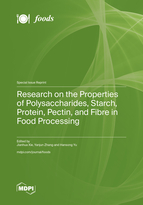Research on the Properties of Polysaccharides, Starch, Protein, Pectin, and Fibre in Food Processing
A special issue of Foods (ISSN 2304-8158). This special issue belongs to the section "Food Physics and (Bio)Chemistry".
Deadline for manuscript submissions: closed (31 May 2022) | Viewed by 102575
Special Issue Editors
Interests: polysaccharide; functional foods; microbiome; hydrocolloids; biopolymers
Special Issues, Collections and Topics in MDPI journals
Interests: starch; properties; structure; physical modification
Special Issues, Collections and Topics in MDPI journals
Interests: protein; dietary fibre; functional foods; carbohydrate; high-value processing
Special Issues, Collections and Topics in MDPI journals
Special Issue Information
Dear Colleagues,
Food components are the most widespread natural products such as polysaccharides, starch, protein, pectin, and fibre, present in all organs of most higher plants. Due to its unique physico-chemical properties (dependent on the botanical origin, geographical origin, culture conditions, etc.), they are highly valued and frequently used in various industries. With the advancement of the isolation technology, as well as with the development of enzyme engineering and the application of modern modification technologies, food components have become very important raw material for the production of numerous products in the food industry, but also in various other industries, such as paper, textile, building materials, pharmaceutical, chemical, and others.
Native components isolated from raw materials such as cereals, vegetables, meat, fruits and others have limited application due to a number of disadvantages such as solubility at lower temperatures, instability under certain conditions, viscosity change, lack of functional properties, etc. In order to overcome these problems and expand the possibilities of their application in food and non-food industries, and to obtain changed physicochemical and enhanced functional properties, chemical, physical, and enzymatic modification procedures (in combination with each other) must be performed. Although an increasing number of studies have recently addressed physical and enzymatic modification processes, the most properties and mechanism of food processing are still unknown.
Therefore, we believe that this Special Issue in the journal Foods focused on research on the properties of polysaccharides, and starch, protein, pectin, and fibre in food processing will provide an overview of the current status and future developments in the field.
The Special Issue will cover the following scientific topics:
Physico-chemical and functional properties native polysaccharides, and starch, protein, pectin, and fibre;
- Food technology of polysaccharides, and starch, protein, pectin, and fibre;
- Modification and application of polysaccharides, and starch, protein, pectin, and fibre;
- Future industry of polysaccharides, starch, protein, pectin, and fibre;
- Novel natural bioactive food carbohydrates, protein and their prospective applications;
- Any topics that are deemed relevant to the main scope of this Special Issue.
Prof. Dr. Jianhua Xie
Dr. Yanjun Zhang
Prof. Dr. Hansong Yu
Guest Editors
Manuscript Submission Information
Manuscripts should be submitted online at www.mdpi.com by registering and logging in to this website. Once you are registered, click here to go to the submission form. Manuscripts can be submitted until the deadline. All submissions that pass pre-check are peer-reviewed. Accepted papers will be published continuously in the journal (as soon as accepted) and will be listed together on the special issue website. Research articles, review articles as well as short communications are invited. For planned papers, a title and short abstract (about 100 words) can be sent to the Editorial Office for announcement on this website.
Submitted manuscripts should not have been published previously, nor be under consideration for publication elsewhere (except conference proceedings papers). All manuscripts are thoroughly refereed through a single-blind peer-review process. A guide for authors and other relevant information for submission of manuscripts is available on the Instructions for Authors page. Foods is an international peer-reviewed open access semimonthly journal published by MDPI.
Please visit the Instructions for Authors page before submitting a manuscript. The Article Processing Charge (APC) for publication in this open access journal is 2900 CHF (Swiss Francs). Submitted papers should be well formatted and use good English. Authors may use MDPI's English editing service prior to publication or during author revisions.
Keywords
- polysaccharide
- starch
- protein
- pectin
- fiber
- properties
- modification
- bioactivities








